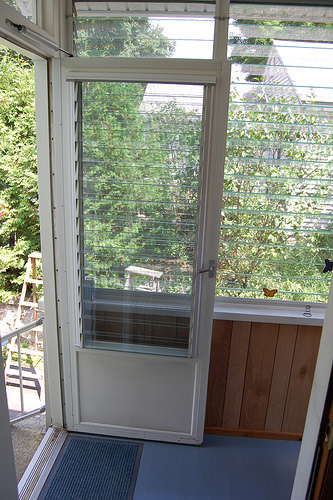.jpg) |
Campers with Anita Bryant (I'm the blonde).
Photo appeared first in Boca Raton News July 25, 1972 |
In July, 1972, my parents sent me off to yet another summer camp. This one, however, was different. No tent in the woods. No canoeing. Campers stayed in the old Bibletown hotel rooms on the grounds of what was originally part of the Boca Raton US Army Air Field. We had meetings and meals in the former officers' club. Built of Dade County pine, it wasn't a fancy building and the hotel rooms were at least twenty years old.
The jalousie windows were a clue to the age of the buildings. Popular in Florida in the fifties and sixties, the louvered panes of glass on a hand crank system were not used as much in buildings built in the seventies. The grounds were landscaped sparingly with tropical plants and the pool was nice and cool.
Bibletown itself was the brainchild of Ira Lee Eshleman, a Christian radio commentator from Miami (originally from Detroit) who decided that paradise needed a "Winter Conference Bible Ground." It was a place for Christians to vacation and worship at the same time. Housed in buildings from the old air field, the site grew and expanded to eventually fill 320 acres.
 |
| Anita Bryant Early Years |
For one year only, Bibletown was the site of the Anita Bryant Summer Camp for Girls. Yep. Anita Bryant. Remember her? In the early seventies, she was known primarily as a singer and beauty queen. The campers were in awe of her. She was on television constantly as the spokeswoman for Florida Orange Juice. Anyone remember, "A day without orange juice is like a day without sunshine?"
Together with her then husband, Bob Green, a former Miami disc jockey, she ran the camp. Bob was always dressed in tennis whites, striding around the camp in a hurry. Days were filled with bible studies, swimming and crafts. Campers were surprised one day to meet astronaut Jim Irwin who brought a moon rock to show and tell. I was certainly impressed to meet him, but I don't remember a thing he said.
The big event at the end of the camp session was a talent show. Back then, most of my friends thought we just needed to be discovered to be big stars like Anita. I wrote a song called "America," played the guitar and sang. I knew it was my big break. Anita would be totally impressed and I would soon be famous. I nervously sat on a stool in front of a room of parents, campers and Anita and sang:
"America, America, I love you with all my heart."
(Knock on the guitar twice.)
"America, America, we two will never part."
(Knock on the guitar twice.)
Four years after the camp, Bibletown suffered a huge fire which destroyed the cafeteria and conference center (former officers' club). Shortly after, houses were built on some of the property and most of the land was sold off. Bibletown, now Boca Raton Community Church, operates on the remaining twenty acres.
As for Anita Bryant, she became embroiled in anti-gay rights legislation in Miami beginning in 1977. Her vehement opinions led to the end of her days promoting orange juice. Her divorce from Bob Green led to desertion by those who had supported her anti-gay stance and Anita gradually lost her sparkle. In 2011, she turned 71 and is now involved in youth charity organizations. She also runs Anita Bryant Ministries International. Her former husband died this past February (2012) in Miami Beach.
While I don't share the beliefs that led to Anita Bryant's downfall, I regret that her beautiful singing voice was lost in the controversy. I don't remember the last time I heard her sing, although it was probably at that summer camp. Her voice was full and rich and I could have listened for hours.
As for me, I know you'll be shocked to find out I wasn't discovered. I'm not famous. And you can all breathe a sigh of relief that the two lines of "America" recited above are the only two lines I remember. The rest are lost in time. (Thank heavens.)
Copyright (c) 2012 Ruth Hartman Berge

.jpg)
.jpg)








